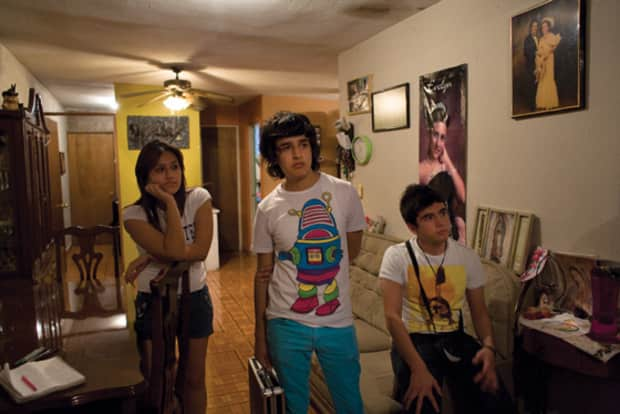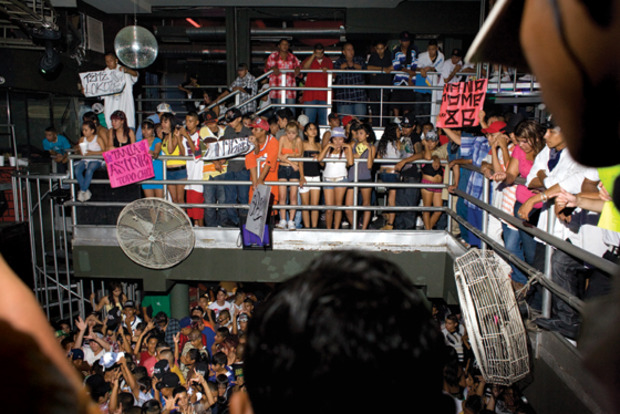Erick Rincon is only 16 years old. Level-headed and soft-spoken, the teenager radiates preternatural calm as he and some of his friends fold into a tiny studio in the back of his parents’ Monterrey, Mexico apartment. “I’m crazy!” interrupts one, who immediately starts beatboxing. “I wasn’t learning anything, so I dropped out of school two years ago,” Rincon says. The young producer doesn’t own a microphone but the MCs come by anyhow. Rincon squints at his computer screen through shaggy hair, wearing a day-glo T-shirt, skinny Smurf-colored jeans, and white Chuck Taylors. “What month is it?” He fi nds his latest project fi les, boots up FruityLoops, and his overworked PC speakers burst into life. A steady house kick-drum gets crosshatched by rootsy percussion swinging hard in a different time signature. Electro synths repeat a staccato riff, but the bassline dreams of Mexican tubas playing polka. Right before the track starts to makes sense, it downshifts into a cumbia break. At tomorrow’s party, this is the precise moment when over 3000 kids will scream and throw their hands into the air, but tonight Rincon’s tweaking sample settings with sound libraries nabbed off tribalero chatrooms, prepping for the quinceañera he’s DJing later. His mother sticks her head in: “They get so into the music! Sometimes they don’t leave this room, they just sleep on the fl oor.” The music is tribal guarachero—clubbed out sounds that draw on regional folk songs and post-emo culture, cholo attitude and electro-house to create the distinctly Mexican sounds of the 21st century’s newest music.
Five years ago this music didn’t exist. Today, tribal guarachero soundtracks tough girls’ sweet 15 parties. Rincon’s cowboy brother skips through north Mexican tunes as he drives us to Royal Diamond function hall for the quinceañera. KFC, Starbucks and cheesy Tex-Mex chains can all afford to keep signage blazing after closing hours, so illuminated logos of American brands dot Monterrey’s nightscape. But the only places to get food at this hour are bare-bulb taco stands, and those sparkling lights clustered in the hills mark rough barrios like La Independencia, home to next-level cumbia wizards and gangsta foot soldiers rocking Ed Hardy gear.
Security guards let us in. Wearing a skimpy electric-blue tutu, birthday girl Nalleley dances with her father as mariachis play “The Last Doll.” Everybody knows the words, everybody knows the moves. Their strummed guitars start to resemble sped-up guaracha—the scraper percussion rasping out cumbia’s telltale shuffl e. The more local Mexican music you hear, the more you’ll catch structures and rhythms which tribal guarachero has cannibalized.
When tribal (“tree-BALL”) first started bubbling out of Mexico City around 2005, they called it “tribal pre-Hispanic,” after Ricardo Reyna’s “La Danza Azteca”—the first tune to pull pre-Colombian samples into tribal house. This is what “tribal” now refers to: not tribal house, but Tribes—Aztec and “African,” which the music evokes via clip-clopping drum grooves and twee pre-Hispanic melodies. In Mexico City’s massive Zócalo plaza, which forms the new sound’s mythic home, Indians play flutes and drums in Aztec costumes, spicing the city’s unhealthy air with their burnt frankincense. The nearby pirate marketplace of Tepito stocks countless low-bitrate tribal CD-Rs. Rewind 500 years, before the Spanish arrived: Zócalo was the center of Tenochtitlan, the Aztec island-metropolis that happened to be one of the world’s largest cities. Workers building a subway line in the 1970s found leftover pyramids. Tepito has been an active market since Aztec days, too. “In Mexico,” writes novelist Carlos Fuentes, “all times are living, all pasts are present.” Tribal guarachero agrees, churning out futuristic bangers fed on hearty servings of ancient music.
The genre morphed into “tribal guarachero” when D.F. innovators like DJ Mouse started pulling in elements of cumbia and Afro-Cuban traditions. Tribal and reggaeton have always shared crowds, although reggaeton has been steadily stealing heat (and producers) from Mexico City’s tribal scene. No worries: Mexican youth subculture mutates and spreads faster than the speed of fl ogs. Tribal’s sound has reached Oaxaca, Veracruz, Guerrero, and beyond—but it’s in the north Mexico outpost of Monterrey where tribal guarachero is growing up fast.
Every Sunday afternoon, roughly 4000 teens gather at the ArcoIris club in downtown Monterrey. Standing outside the venue’s nondescript doorways, it’s impossible to guess what’s happening inside. Twin brothers in clown makeup sit on the curb, too poor to enter. Admission costs about $3 for boys, $2 for girls. Baldhead cholos with their eyebrows shaved off walk by wearing near-identical brown button-up shirts and oversized khaki shorts, their white socks pulled high. A woman in a Saint Judas T-shirt sells loose cigarettes, amaranth bars, and tiny plastic-wrapped studs so the kids can customize their piercings before entering. The boys pay more attention (and money) to their hairdos and clothes than the girls, who gravitate towards halter-tops and hot pants—sexy/functional for the sticky, 100-degree heat.
The teen tribes all find meaning in this new music. There are also los Texas, Monterrey’s take on the cholo style; los fachas, emos with a punky edge; reggaetoneros and more. The most wildstyle are los Colombianos, hood fashion visionaries who gel their hair into extravagant spiked sideburns with big patches shaved away, dressing baggy and colorful, with suspenders, high-perched baseball caps, and Virgin de Guadalupe accessories. The “Colombians” exude gangsta Catholic manga vibes from a decidedly street perspective.
Inside Arco, Rincon’s DJ partner Sheeqo spins first, with Harry Potter projected behind him and the club’s co-ed dance squad in front. You can’t see the stage from entire wings of the club, but the party rages there, too. Wildy unmodulated, post-pubescent sexuality and hyperkinetic adolescent energy reach new peaks with the tribal beats. There is no norm. A boy who can’t be more than nine grinds with a girl nearly twice his size and age. The dancers’ cages are open to all: they fi ll with a fearless range of body types, and it’s all being documented via cellphone pics. Many kids don’t have computers or regular internet access, but everybody here sweats Fotolog, and its social network of floggers from all over the world. “It’s the easiest way to get known in Monterrey,” says Rincon. The Sunday parties provide extra incentive to upload photos of their looks and lives as a mad acceleration of fashion paralleling the evolving music.
It’s hard to believe that the U.S. border is only two hours away, but that’s the magic of Monterrey, Mexico’s richest city. The confi dent sprawl exerts its own cultural gravity. Closeness to the U.S. keeps it looking outward. The city prides itself on a century of bustling industry, a long legacy of bringing raw material from around the Americas, where they get transformed, capitalized on, and exported. Same thing happens with the music. Outside of Mexico, DJs like Sinden, J-Wow from Buraka Som Sistema and Nguzunguzu are starting to spike their sets with tribal guarachero. Hovering around 130BPM, the music’s syncopated street bump blends well across the house spectrum. Crowds in London or New York may hear it as quirky, catchy house with funky shuffl es, but back in Monterrey it’s aligned closely enough with uncool working class music that I saw Rincon and Sheeqo clear the dancefl oor during their fi rst-ever performance for non-teenagers at the upscale venue Jaguar House. The kinetic pull of their music eventually won crowds back, shaking out class divides as everybody got crunk. In their home territory of ArcoIris, these kids are kings from start to finish.
Sheeqo tends towards percussion-heavy tracks. Rincon’s set is more playful. Simple three-note basslines pump along frisky drum patterns. The genre has gotten more synthy over the past few years, and part of Rincon’s mission is to integrate synth melodies with his beloved cumbia and pre-Hispanic. Most of the music played is his own—“Cumbia de Nuevo León Remix,” “La Bomba Remix,” “Magdalena”—and he mixes energetically. While tribal guarachero has signature sounds, the party DJs stay open: They take extended forays into reggaeton, some crunk en Español or, at the right moment, a slowed-down cumbia rebajada. When they drop reggaeton, they don’t play radio-ready summer tunes, which are big across Mexico. They play beats: dancefl oor edits, chopped up vocals. Dem Bow is everywhere. The signature bass/guitar lick from Chaka Demus & Pliers’ reggae classic “Murder She Wrote” is the most common sample of the day.
"Tribal Guarachero is catharsis, sonic catharsis." —Toy Selectah
Monterrey’s love affair with bassy dance music, accordions (sampled or real), and technology goes back at least four decades, when they invented a new genre just by pitching cumbia records way down. “The music was getting too fast to dance to,” say Marquillos Colombia, the cumbia rebajada specialist, “so we slowed it down.” Marquillos has been supplying Monterrey’s cumbia fans for 15 years from a tiny sidewalk stand. On his arm, a time-smudged tattoo shows a red-eyed Donald Duck clutching a bottle of liquor as he confronts a cop in full riot gear. Three of us crowd under his sheet-metal roof to escape a tropical downpour; the fourth guy doesn’t fit and stands outside with a plastic bag on his head. Marquillos plays another rebajada at stomach-rattling volume, then resumes talking quietly. He explains that Monterrey’s obsession with Colombian cumbias goes deep, they just have to adjust it sometimes: changing the tempo, replaying it with local bands to draw the bass and grooves away from Colombian virtuosity. Everywhere else in the world, these dusty old cumbias are seen as old people’s music, but here, teenagers are some of his best customers.
These young tribaleros were in diapers back in 1996 when Toy Selectah’s hip-hop group, Control Machete, sold over a half-million copies of their debut album. Alongside Control, Monterrey bands like El Gran Silencio, Plastilina Mosh, and Kinky drew on rock, rap, and a wealth of Mexican styles, successfully exploding onto the international tour circuit. In 2001, Toy Hernández produced the dubwise cumbia-reggae crossover hit “Cumbia Sobre El Rio” for OG Monterrey accordionist Celso Piña. The title references La Puente del Papa (“the Pope’s Bridge”)—a mecca for music heads which links La Independencia to downtown.
“At La Puente del Papa I got to meet some of the old school Sonideros,” says tropical dance producer/DJ Chico Sonido. “They would not only have cumbias and tropical music, but they also had a lot of funk, psychedelic rock and disco.” Toy and Chico came of age in the ’90s—LPs, cassettes, turntables. For tribal guarachero kids, historical lineage gets trumped by YouTube’s “related video” links. “I surf YouTube for things to sample,” says Rincon, “then try to fi nd the audio download.”
Producer, Grammy-winner for his production work with Calle 13, and one of those rare dudes who decorates astute observations with trucker-grade swears in English and Español, Toy Selectah raps about “a truly strange mental confusion” in Mexican youth culture, like the way Israeli psy-trance (they call it “psycho”) went big in Mexico. “The same person will be listening to psycho, Tiesto, Paul Van Dyk and Los Tucares de Tijuana. That person will be also listening to pre-Hispanic drums and percussion from who knows where, saying ‘I don’t know where these drums are from. I fucking love santeria and I don’t understand it but I’ll use it. Plus I’m gonna put on some berimbau, though I don’t know if it’s from Brazil or what.’ Tribal guarachero is catharsis, sonic catharsis.”
The genre creates a space where kids can playfully experiment how local roots (from psycho to narcocorridos) tangle with random internet click-trails (inexplicably, it samples lots from Egyptian percussionist Hossam Ramzy). This explains those mysterious swinging triplet beats in tribal. The Monterrey kids grew up hearing rancheras, huapangos and corridos, all in 3/4 time. This meter reappears in folk music across Latin America, and it creeps into tribal even though they’re using software that defaults to 4/4 beat structures. Kids all over the world make tracks with FruityLoops, but you have to be strong or stubborn to pack it so thick with structural references to other Mexican music—particularly folding in those alternate time signatures, those sneaky triplets that move the body more subtly. This is why Toy Selectah’s convinced tribal guarachero will end up in the rodeos, random bars, at places all over the diaspora—because it is straight-up unromantic Mexican dance music, and they’ll instantly hear its roots and understand where it’s coming from. The Mexican-time at the heart of tribal guarachero sets it apart from other more visible genres of global bass. “For some reason I never got into experimenting with Baltimore, baile funk or kuduro sounds,” says Chico Sonido. “But tribal guarachero, I can feel it, makes a lot of sense to me.” He calls it “Aztec Rave from the future.”
When his insane international DJ schedule allows, Toy Selectah mentors Rincon and Sheeqo, offering studio advice, sharing music on YouTube, whatever he can to keep the movement positive. It’s a version of what he’ll be doing when he labs up with old friends Calle 13 in Miami next week: vibing, helping musicians to connect the dots and draw out a bigger picture. “The music is in the hands of the DJs producing it, the whole industry circle hasn’t hit yet. There aren’t singers, there aren’t rappers. Right now it’s music for the club,” he explains. “Same thing happened in reggaeton—back then, it was simply known as ‘underground.’” Toy knows: he spent several years doing hip-hop and reggaeton A&R for Universal. “In two, three years, there’ll be tribal guarachero singers and MCs and songs with the rhythm. My head spins thinking that we should be doing it!”
And they are. While the mainstream media’s narrative for Monterrey tells of a formerly safe city ravaged by encroaching drug wars (nearly 300 people were killed there this year), tribal guarachero’s potency and exuberance tells the other story: irrepressible youth culture sweating it out in a healthy scene so hype that they barely have time to realize what’s being created. Rincon just gave away 40 tracks of his online, “for the people who don’t have my tunes from 2009 and 2010.” He’s naturally generous and knows that the best is yet to come. The stream of kids exiting Arco in time to hop on the free Sunday metro towards home agree—they’ll be back next week.





